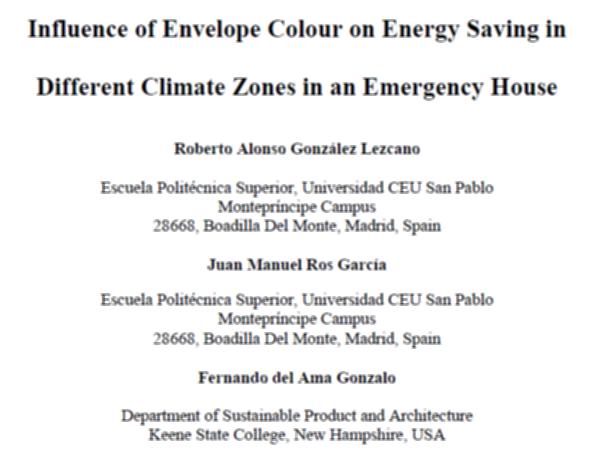Por favor, use este identificador para citar o enlazar este ítem:
http://hdl.handle.net/10637/15826Influence of Envelope Colour on Energy Saving in Different Climate Zones in an Emergency House

Ver/Abrir:
Influence_Gonzalez_Ros_Ama_HIKARI_2020.PNG
35,29 kB
image/png
Ver/Abrir:
Influence_Gonzalez_Ros_Ama_HIKARI_2020.pdf
Acceso restringido
790,71 kB
Adobe PDF
Request a copy
| Título : | Influence of Envelope Colour on Energy Saving in Different Climate Zones in an Emergency House |
| Autor : | González Lezcano, Roberto Alonso. Ros García, Juan Manuel Del Ama Gonzalo, Fernando |
| Materias: | Sustainability; Green building; Emergency house |
| Editorial : | Hikari |
| Citación : | Gonzalez-Lezcano, Roberto Alonso & Ros-García, Juan & del Ama Gonzalo, Fernando. (2020). Influence of Envelope Colour on Energy Saving in Different Climate Zones in an Emergency House. Contemporary Engineering Sciences. 13. 69-87. 10.12988/ces.2020.91244 |
| Resumen : | The VEM project ( Emergency house project ) aims a series of objectives based on energy efficiency through the study of basic parameters, by natural systems, to reach climatic comfort: the influence of the form factor in the climatic performance, the orientation, ventilation, and an adequate performance towards the temperature and humidity conditions that the different climate zones offer. From the resulting data, the validity in the performance of the VEM project’s constructive system is verified based on its energy simulation. The study begins with the energy simulation of the project with the Ecotect Analysis program, in five locations: continental Mediterranean climate (Madrid), monsoon climate (New Delhi), tropical climate (Brasilia), continental humid climate (Montreal), and semiarid climate (Karachi); considering its constructive system, materials, orientation, ventilation, incident solar radiation, environmental conditions (temperature, wind, rainfall), generating a study on technical control and the degree of environmental influence on the project. In every location, the behavior is simulated for both a cold and a warm day, recollecting data on Wh (energy gains and losses) and interior temperature, considering the variations throughout the day. The second part of the study goes beyond the simulation, with the aim to improve the first results and delve more deeply into the materials of the envelope, the color and the material’s reflection, studying the effects produced on the interior temperature, taking into account the region and climate of the simulation. It also addresses the positive effect produced by the form factor applied in the VEM project, its advantages compared to other designs with different form factors; all to amend possible thermal tolerances and allow comfort in the interior of the living space. |
| URI : | http://hdl.handle.net/10637/15826 |
| Derechos: | http://creativecommons.org/licenses/by-nc-nd/4.0/deed.es |
| ISSN : | 1313-6569 |
| Fecha de publicación : | 2020 |
| Centro : | Universidad San Pablo-CEU |
| Aparece en las colecciones: | Escuela de Politécnica Superior |
Los ítems de DSpace están protegidos por copyright, con todos los derechos reservados, a menos que se indique lo contrario.

